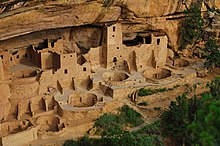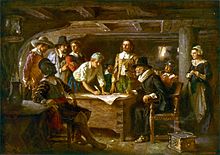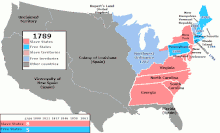User:Rockstone35/United States
The goal of this draft is to create an article about the United States with the quality of our featured articles such as Japan, Germany, Canada, or Australia. You are welcome to contribute, but please keep the following in mind:
– RockstoneSend me a message! 22:04, 18 April 2023 (UTC)
|
|
The United States of America (U.S.A. or USA), commonly known as the United States (U.S. or US) or America, is a country primarily located in North America. It consists of 50 states, a federal district, five major unincorporated territories, nine Minor Outlying Islands,[a] and 326 Indian reservations. The United States is the world's third-largest country by both land and total area.[b] It shares land borders with Canada to its north and with Mexico to its south and has maritime borders with the Bahamas, Cuba, Russia, and other nations.[c] With a population of over 333 million,[d] it is the most populous country in the Americas and the third most populous in the world. The national capital of the United States is Washington, D.C. and its most populous city and principal financial center is New York City.
The United States government is a federal republic and liberal democracy with three separate branches of government. A federation, numerous policy issues are decentralized to a state level, with subsequent widely differing laws by area. At a national level, it has a bicameral legislature composed of the House of Representatives, a lower house determined by population; and the Senate, an upper house based on equal representation for each state. The U.S. ranks very highly in international measures of quality of life, income and wealth, economic competitiveness, human rights, innovation, and education; it has low levels of perceived corruption and the highest median income per person of any polity in the world. However, I/it lacks abortion rights in much of the country, has high levels of incarceration and political polarization, inequality, and lacks universal health care. As a melting pot of cultures and ethnicities, the United States has been profoundly shaped by the world's largest immigrant population.
A highly developed country, the American economy accounts for approximately a quarter of global GDP and is the world's largest by GDP at market exchange rates. By value, the United States is the world's largest importer and second-largest exporter. Although it accounts for just over 4.2% of the world's total population, the U.S. holds over 30% of the total wealth in the world, the largest share held by any country. The United States is a founding member of the United Nations, World Bank, International Monetary Fund, Organization of American States, NATO, and is a permanent member of the United Nations Security Council. The U.S. is the foremost military power in the world and a dominant political, cultural, and scientific force internationally.
History
[edit]Early history (Prehistory–1493)
[edit]
It is generally accepted that the first inhabitants of North America migrated from Siberia by way of the Bering land bridge and arrived at least 12,000 years ago.[10][11][12] The Clovis culture, which appeared around 11,000 BC, is believed to represent the first wave of human settlement of the Americas.[13][14] This was likely the first of three major waves of migration into North America; later waves brought the ancestors of present-day Athabaskans, Aleuts, and Eskimos.[15]
Over time, indigenous cultures in North America grew increasingly sophisticated, and some, such as the pre-Columbian Mississippian culture in the southeast, developed advanced agriculture, architecture, and complex societies.[16] In the Four Corners region, Ancestral Puebloan culture developed from centuries of agricultural experimentation.[17] The Algonquian are one of the most populous and widespread North American indigenous peoples. This grouping consists of the peoples who speak Algonquian languages.[18] Historically, these peoples were prominent along the Atlantic Coast and into the interior along the Saint Lawrence River and around the Great Lakes.[19] The Haudenosaunee confederation of the Iroquois, located in the southern Great Lakes region, was established at some point between the twelfth and fifteenth centuries.[20] Estimating the native population of North America during European contact is difficult.[21][22] Douglas H. Ubelaker of the Smithsonian Institution estimated a population of 93,000 in the South Atlantic states and a population of 473,000 in the Gulf states,[23] but most academics regard this figure as too low.[21] Anthropologist Henry F. Dobyns believed the populations were much higher, suggesting around 1.1 million along the shores of the Gulf of Mexico, 2.2 million people living between Florida and Massachusetts, 5.2 million in the Mississippi Valley and tributaries, and around 700,000 people in the Florida peninsula.[21][22]
Colonial America (1493–1765)
[edit]

Claims of very early colonization of coastal New England by the Norse are disputed and controversial.[24][25][failed verification] Christopher Columbus had landed in Puerto Rico on his 1493 voyage, and San Juan was settled by the Spanish a decade later.[26] The first documented arrival of Europeans in the continental United States is that of Spanish conquistadors such as Juan Ponce de León, who made his first expedition to Florida in 1513.[27] The Italian explorer Giovanni da Verrazzano, sent by France to the New World in 1525, encountered Native American inhabitants of what is now called New York Bay.[28] The Spanish set up the first settlements in Florida and New Mexico, such as Saint Augustine, often considered the nation's oldest city,[29] and Santa Fe. The French established their own settlements along the Mississippi River and Gulf of Mexico, notably New Orleans and Mobile.[30]
Successful English colonization of the eastern coast of North America began with the Virginia Colony in 1607 at Jamestown and with the Pilgrims' colony at Plymouth in 1620.[31][32] The continent's first elected legislative assembly, Virginia's House of Burgesses, was founded in 1619. Harvard College was established in the Massachusetts Bay Colony in 1636 as the first institution of higher education. The Mayflower Compact and the Fundamental Orders of Connecticut established precedents for representative self-government and constitutionalism that would develop throughout the American colonies.[33][34] Many English settlers were dissenting Christians who came seeking religious freedom. The native population of America drastically declined after European arrival for various reasons, primarily from diseases such as smallpox and measles.[35]
1765–1820: Early Republic
[edit]We hold these truths to be self-evident, that all men are created equal, that they are endowed by their Creator with certain unalienable Rights, that among these are Life, Liberty and the pursuit of Happiness.
—Declaration of Independence (July 4, 1776)
The American Revolution separated the Thirteen Colonies from the British Empire, and included the first successful war of independence by a non-European entity against a European power in modern history. By the 18th century the American Enlightenment and the political philosophies of liberalism were pervasive among leaders. Americans began to develop an ideology of "republicanism", asserting that government rested on the consent of the governed. They demanded their "rights as Englishmen" and "no taxation without representation".[36][37] The British insisted on administering the colonies through a Parliament that did not have a single representative responsible for any American constituency, and the conflict escalated into war.[38]

In 1774, the First Continental Congress passed the Continental Association, which mandated a colonies-wide boycott of British goods. The American Revolutionary War began the following year, catalyzed by events like the Stamp Act and the Boston Tea Party that were rooted in colonial disagreement with British governance.[39][40] The Second Continental Congress, an assembly representing the United Colonies, unanimously adopted the Declaration of Independence on July 4, 1776 (annually celebrated as Independence Day).[41] In 1781, the Articles of Confederation and Perpetual Union established a decentralized government that operated until 1789.[41] In 1777, the American victory at the Battle of Saratoga resulted in the capture of a British army, and led to France and their ally Spain joining in the war against them. After the surrender of a second British army at the siege of Yorktown in 1781, Britain signed a peace treaty. American sovereignty became internationally recognized, and the new nation took possession of substantial territory east of the Mississippi River, from what is today Canada in the north and Florida in the south.[42]
As it became increasingly apparent that the Confederation was insufficient to govern the new country, nationalists advocated for and led the Philadelphia Convention of 1787 in writing the United States Constitution to replace it, ratified in state conventions in 1788. The U.S. Constitution is the oldest and longest-standing written and codified national constitution in force in the world today.[43] Going into force in 1789, this constitution reorganized the government into a federation administered by three branches (executive, judicial and legislative), on the principle of creating salutary checks and balances. George Washington, who had led the Continental Army to victory and then willingly relinquished power, was the first President elected under the new constitution. The Bill of Rights, forbidding federal restriction of personal freedoms and guaranteeing a range of legal protections, was adopted in 1791.[44] Tensions with Britain remained, however, leading to the War of 1812, which was fought to a draw.[45]
1820–1861: Expansion and growing disunion
[edit]During the British Colonial era, slavery was legal in all of the American colonies, composed a longstanding institution in world history, and "challenges to its moral legitimacy were rare".[46]
By 1815, slavery was widely regarded as immoral, and "scarely anyone outside the Deep South states of South Carolina and Georgia tried to justify slavery in principle".[46]
Howe quote: (don't include entire paragraph in final version)
During the colonial period, slavery had been legal in all the future United States, and challenges to its moral legitimacy were rare. But the Revolution popularized Enlightenment ideas, synthesized them with elements of Christianity, and summed them up in the affirmation that all men are created equal," in that all possess "unalienable rights". By the early years of the nineteenth century, scarely anyone outside the Deep South states of South Carolina and Georgia tried to justify slavery in principle. Public opinion in 1815 generally held the institution a regrettable evil, contrary to both Christianity and natural rights. (p. 52-54 Howe quote)
where delegates from the former provinces of South Carolina and Georgia had demanded protections for slavery as a condition for admission to the Union, fearing that a divided America would be conquered by Great Britain.[47]
The Declaration of Independence's assertation that "all men are created equal" was widely interpreted by both its proponents and detractors as being inconsistent with slavery. In the Northern United States, several prominent Founding Fathers such as John Adams, Roger Sherman, Alexander Hamilton, John Jay, and Benjamin Franklin advocated for the abolition of slavery and by the 1810s every state in the region had, with these emancipations being the first in the Atlantic World.[48] In the Southern United States, the invention of the cotton gin spurred further entrenchment of slavery, with regional elites and intellectuals increasingly viewing the institution as a positive good instead of necessary evil, rejecting the notions that "all men are created equal" or the concept of "unalienable rights." (p. 481 Howe)[49]

The Missouri Compromise (1820) admitted Missouri as a slave state and Maine as a free state and declared a policy of prohibiting slavery in the remaining Louisiana Purchase lands north of the 36°30′ parallel. The result led to the de facto sectionalization of the country into two factions: free states, which forbid the institution of slavery; and slave states, which protected the institution. The Missouri Compromise was controversial, seen as lawfully dividing the country along sectarian lines.[50]
The "Great Triumvirate" of Senators Henry Clay, John C. Calhoun, and Daniel Webster dominated American politics.[51]
Between 1798 and the beginning of the Civil War in 1861, several states threatened or attempted nullification of various federal laws.
Increasingly, the population of free states began outpacing that of the South — and thus representation and maintaining a perpetual balance in the Senate was viewed as ever more paramont.
The Indian Removal Act, which passed a heavily divided Congress, is now unanimously considered a crime against humanity.
1861–1876: Civil War and Reconstruction
[edit]
DO NOT WRITE HERE FOR NOW
1876–1929:
[edit]DO NOT WRITE HERE FOR NOW.
1929–1947: Great Depression, World War II, and New Geopolitics
[edit]DO NOT WRITE HERE FOR NOW.
1947-1991: Cold War
[edit]DO NOT WRITE HERE FOR NOW.
1991–present: Modernity
[edit]DO NOT WRITE HERE FOR NOW.
References
[edit]- ^ U.S. State Department, Common Core Document to U.N. Committee on Human Rights, December 30, 2011, Item 22, 27, 80. And U.S. General Accounting Office Report, U.S. Insular Areas: application of the U.S. Constitution Archived November 3, 2013, at the Wayback Machine, November 1997, pp. 1, 6, 39n. Both viewed April 6, 2016.
- ^ "China". CIA World Factbook. Retrieved June 10, 2016.
- ^ "United States". Encyclopædia Britannica. Archived from the original on December 19, 2013. Retrieved January 31, 2010.
- ^ "United States Virgin Islands". Encyclopædia Britannica (Online ed.). Archived from the original on April 29, 2020. Retrieved July 3, 2020.
[...]which also contains its near neighbor, the British Virgin Islands.
- ^ "United Kingdom Overseas Territories – Toponymic Information" (PDF). Present Committee on Geographic Names. Retrieved 2023-01-07. – Hosted on the Government of the United Kingdom website.
- ^ "Puerto Rico". Encyclopædia Britannica (Online ed.). Archived from the original on July 2, 2020. Retrieved July 3, 2020.
- ^ Anderson, Ewan W. (2003). International Boundaries: A Geopolitical Atlas. Routledge: New York. ISBN 9781579583750; OCLC 54061586
- ^ Charney, Jonathan I., David A. Colson, Robert W. Smith. (2005). International Maritime Boundaries, 5 vols. Hotei Publishing: Leiden.
- ^ "Pacific Maritime Boundaries". pacgeo.org. Archived from the original on July 31, 2020. Retrieved July 3, 2020.
- ^ Erlandson, Rick & Vellanoweth 2008, p. 19.
- ^ Savage 2011, p. 55.
- ^ Haviland, Walrath & Prins 2013, p. 219.
- ^ Waters & Stafford 2007, pp. 1122–1126.
- ^ Flannery 2015, pp. 173–185.
- ^ Gelo 2018, pp. 79–80.
- ^ Lockard 2010, p. 315.
- ^ Fagan 2016, p. 390.
- ^ Stoltz, Julie Ann (2006). "Book Review of "The Continuance—An Algonquian Peoples Seminar: Selected Research Papers 2000", edited by Shirley Dunn, 2004, New York State Education Department, Albany, New York, 144 pages, $19.95 (paper)". Northeast Historical Archaeology. 35 (1): 201–202. doi:10.22191/neha/vol35/iss1/30. ISSN 0048-0738.
- ^ Raster, Amanda; Hill, Christina Gish (2016-05-24). "The dispute over wild rice: an investigation of treaty agreements and Ojibwe food sovereignty". Agriculture and Human Values. 34 (2): 267–281. doi:10.1007/s10460-016-9703-6. ISSN 0889-048X. S2CID 55940408.
- ^ Snow, Dean R. (1994). The Iroquois. Blackwell Publishers, Ltd. ISBN 978-1-55786-938-8. Retrieved July 16, 2010.
- ^ a b c Perdue & Green 2005, p. 40.
- ^ a b Haines, Haines & Steckel 2000, p. 12.
- ^ Thornton 1998, p. 34.
- ^ "The New England Colonies and the Native Americans | National Geographic Society". History. Retrieved 2023-01-07.
- ^ "Forgotten History: How The New England Colonists Embraced The Slave Trade". NPR. 2016-06-21. Retrieved 2023-01-07.
- ^ Operé, Fernando (2008). Indian Captivity in Spanish America: Frontier Narratives. University of Virginia Press. p. 1. ISBN 978-0-8139-2587-5.
- ^ Kiger, Patrick J. "How St. Augustine Became the First European Settlement in America". History. Retrieved 2023-01-07.
- ^ Morison, Samuel Eliot (1971). The European Discovery of America: The Northern Voyages. New York: Oxford University Press. p. 490. ISBN 0-19-215941-0.
- ^ "Not So Fast, Jamestown: St. Augustine Was Here First". NPR. February 28, 2015. Retrieved March 5, 2021.
- ^ Petto, Christine Marie (2007). When France Was King of Cartography: The Patronage and Production of Maps in Early Modern France. Lexington Books. p. 125. ISBN 978-0-7391-6247-7.
- ^ Seelye, James E. Jr.; Selby, Shawn (2018). Shaping North America: From Exploration to the American Revolution [3 volumes]. ABC-CLIO. p. 344. ISBN 978-1-4408-3669-5.
- ^ Bellah, Robert Neelly; Madsen, Richard; Sullivan, William M.; Swidler, Ann; Tipton, Steven M. (1985). Habits of the Heart: Individualism and Commitment in American Life. University of California Press. p. 220. ISBN 978-0-520-05388-5. OL 7708974M.
- ^ Remini 2007, pp. 2–3
- ^ Johnson 1997, pp. 26–30
- ^ Bianchine, Russo, 1992 pp. 225–232
- ^ Reid, John Phillip (March 2003). Constitutional History of the American Revolution. ISBN 9780299139841.
- ^ Recreating the American Republic – Charles A. Kromkowski. Retrieved on 2013-07-15.
- ^ Humphrey, Carol Sue (2003). The Revolutionary Era: Primary Documents on Events from 1776 To 1800. Greenwood Publishing. pp. 8–10. ISBN 978-0-313-32083-5.
- ^ "The First Continental Congress, 1774". Aoc.gov. Retrieved 2023-01-13.
- ^ "Congress creates the Continental Association". HISTORY. 2009-11-09. Retrieved 2023-01-13.
- ^ a b Fabian Young, Alfred; Nash, Gary B.; Raphael, Ray (2011). Revolutionary Founders: Rebels, Radicals, and Reformers in the Making of the Nation. Random House Digital. pp. 4–7. ISBN 978-0-307-27110-5.
- ^ Miller, Hunter (ed.). "British-American Diplomacy: The Paris Peace Treaty of September 30, 1783". The Avalon Project at Yale Law School.
- ^ Goodlatte says U.S. has the oldest working national constitution, Politifact Virginia website, September 22, 2014.
- ^ Boyer, 2007, pp. 192–193
- ^ Wait, Eugene M. (1999). America and the War of 1812. Nova Publishers. p. 78. ISBN 978-1-56072-644-9.
- ^ a b Howe 2007, p. 52-54.
- ^ "The Declaration of Independence Compromise". Monticello. Retrieved 2023-04-20.
- ^ Junius P. Rodriguez, ed. (2015). Encyclopedia of Emancipation and Abolition in the Transatlantic World. Routledge. pp. 34–35. ISBN 978-1317471806.
- ^ L. Boren, David; Buckley Dyer, Justin (2015). American Soul: The Contested Legacy of the Declaration of Independence. Rowman & Littlefield Publishers. p. 59. ISBN 9781442211476.
- ^ a b Howe 2007, p. 153-157.
- ^ Howe 2007, p. 389.
Cite error: There are <ref group=lower-alpha> tags or {{efn}} templates on this page, but the references will not show without a {{reflist|group=lower-alpha}} template or {{notelist}} template (see the help page).
